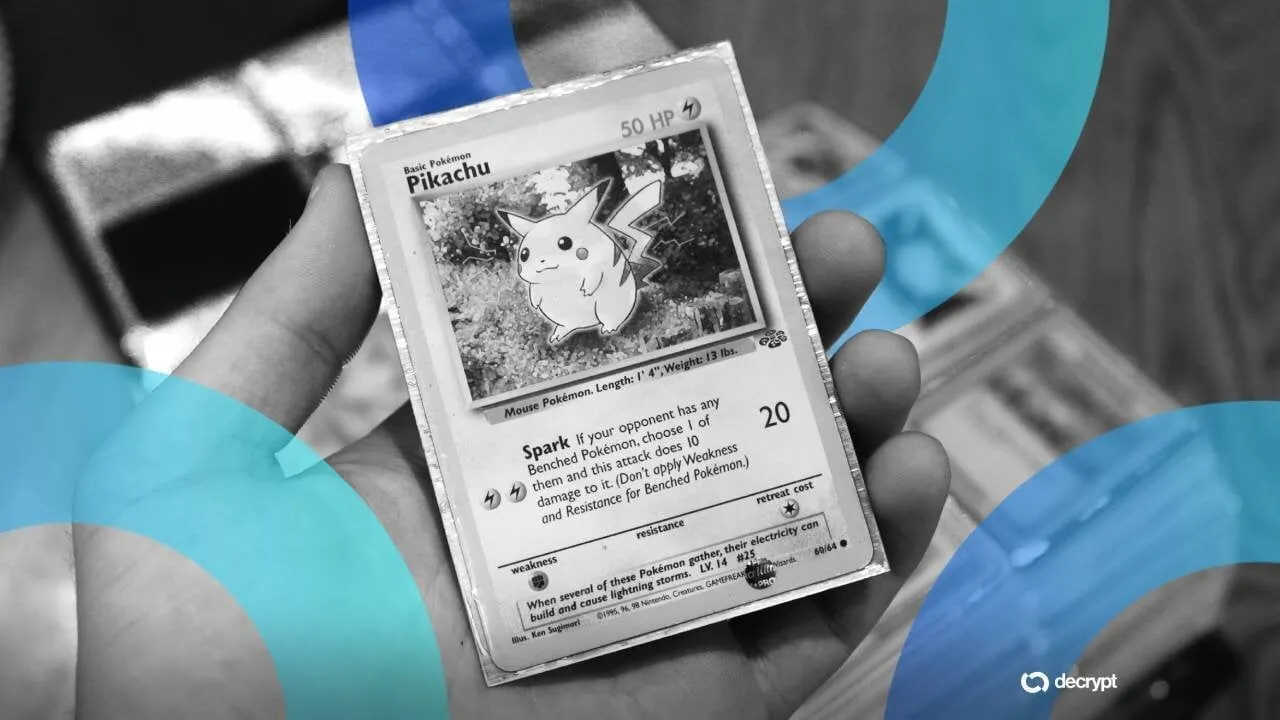In brief
- Tokenized Pokémon cards are having a moment.
- Some developers think that the NFTs can serve as collateral in DeFi.
- Leading tokenized cards platform Courtyard isn’t exploring that, according to its CEO.
A pseudonymous developer in Canada knows that his project’s target demographic cares little about crypto or decentralized finance. For the most part, Pokémon card collectors are a skeptical group, according to the individual who goes by Keef on X.
“These people don’t really want to go on-chain,” he told Decrypt, in reference to NFTs that are redeemable for trading cards from the globally recognized media franchise. “I think a lot of people that aren’t already here are very apprehensive.”
A bigger task than he initially anticipated, Keef is working on a platform that will one day allow people to use digital representations of Pokémon cards as collateral for loans. In his mind, it’s a no-brainer. Who wouldn’t want to put their NFTs on the line to earn a higher return?
“Yes, you can earn some extra money, [...] but that doesn’t really get the neuron spiking for them,” Keef said. “Allowing them to use their cards to buy more cards? That’s huge.”
Keef’s startup, which doesn’t have a name yet, is largely conceptual at this point. He says he’s raising money to fund it, while pushing out mock-ups that lean heavily on Game Boy-era aesthetics. Still, it reflects a broader pattern of experimentation with tokenization and how NFTs representing Pokémon cards are, in some ways, evolving beyond their initial form.
Some experts think that the assets have practical limitations as collateral in DeFi, however, underscoring a broader set of challenges that firms are currently grappling with, whether that’s fragmented markets, real-world data sources, or custodial arrangements.
Pokemon x Crypto.
Not just a trading platform..
Unlock instant liquidity with our Pokémon card lending markets.
Use your cards as collateral to trade. Long your longs at 10x.
(Retail doesn't know what's coming) pic.twitter.com/LBkhXfqSfj
— Keef (@0xKeef) September 2, 2025
Courtyard emerged as a marketplace for tokenized Pokémon cards, and other collectibles, on Ethereum scaling network Polygon in 2021. And its business has been growing steadily since. Last month, for example, the platform generated $78 million in sales volume, a nearly 2,600% increase compared to a year ago, according to a Dune dashboard.
At the same time, marketplaces Collector Crypt and Phygitals have established similar businesses, and they issue their respective NFTs on Solana. Another project called RIP.FUN is in closed beta on the Ethereum scaling network Base. The NFTs issued by these firms are permissionless, so anyone can build an application that supports them on-chain.
If a project wants to cast as wide a net as possible, it would have to support multiple networks—and potentially any other blockchain that tokenized Pokémon cards gain traction on in the future. Keef says he is building toward support for Polygon and Solana, along with layer-1 blockchain Flow.
‘Not a destination’
Courtyard may eventually explore how Pokémon cards can be used in DeFi, but it’s never been a focus for the firm, according to co-founder and CEO Nico le Jeune. Theoretically, it could work, but the appeal would likely be limited to high-value NFTs, he told Decrypt.
“There are Pokémon cards that are worth $200,000, and it might make sense there,” he said. “The value for users to borrow at 12% APR on $100 in cards is less clear.”
Indeed, loans for high-end NFTs are commonplace. CryptoPunks are routinely lent out on the peer-to-peer lending protocols GONDI and NFTfi. Still recognized as digital status symbols, most of the loans that CryptoPunks secure are worth at least $100,000 on GONDI.
Pokémon and other TCGs are about to have their “Polymarket moment.” Here’s why you should be paying attention:
Most of crypto’s teal world asset (RWA) plays cater to well-established TradFi markets, like treasuries, real estate, gold and stocks. Sure, tokenization brings these…
— Danny Nelson (@realDannyNelson) September 3, 2025
Some lending protocols, such as Teller, also support Courtyard’s NFTs. In 2023, someone used the service to take out a $53 loan on their NFT tied to a $300 Venusaur card. The user was liquidated after failing to remake payments on-time, leaving the lender with the user’s NFT at a steep discount. (Keef thinks this is a powerful dynamic for wholesalers looking for cheap cards.)
Those services facilitate loans on a bespoke basis. Each loan is a unique arrangement between a lender and a debtor. With Pokémon cards deriving pricing data from off-chain sources like eBay or TCGPlayer, that makes it harder for lending to take place efficiently, le Jeune said.
“It’s not like an NFT collection, where you can just look at floor price,” he said, referring to the cheapest NFT for sale on a secondary market from a collection.
Blockchains are isolated from outside data sources, so the same barrier applies to digital representations of equities and other assets. As a result, some crypto projects use oracles as a bridge to fetch and verify price data. XStocks’ tokenized stocks, for example, use Chainlink’s infrastructure.
Le Jeune told Decrypt that Courtyard uses pricing data from a company called Card Ladder, which is owned by the same parent company as the third-party grading firm PSA. Still, Courtyard’s terms and services say “the fair market value of the card is determined solely by Courtyard at its discretion and is not subject to negotiation or debate.”
The fair market value of a Pokémon card is core to Courtyard’s most popular product: a “vending machine” that allows customers to purchase a random card across several tiers, which max out at $2,500. Customers can post the NFT for sale on Courtyard’s market, without facing a seller’s fee—or instantly sell it back to Courtyard for 90% of the card’s fair market value.
“That’s novel, and that resonates in crypto or outside crypto,” le Jeune said. “Most of our users don’t even realize they are using crypto rails.”
The service aligns with le Jeune’s belief that “crypto is a tool” for building transparent and scalable services, “not a destination” to drop users into. Collector Crypt and Phygitals offer “gacha” and “claw” machines that feature similar feedback loops, which echo the gambling-like elements of loot boxes seen in a growing number of modern video games.
Labubus tomorrow?
When Keef thinks about his lending service, one of the biggest pitfalls he foresees is the complexity of on-chain loans. The service might not be appealing if users are constantly being liquidated, or having their loans forcibly closed due to a fall in their collateral’s value.
That’s why Keef says he’s keeping his project focused on high-value cards.
“The price won’t fluctuate [as much],” he said. “That way someone won’t get liquidated by somebody selling three or four cards” and causing its price to move.
But that’s far from the only place where things could go wrong for users, according to Ryan Zurrer, the founder of Dialectic, a Swiss-based family office. One of the biggest barriers for tokenized Pokémon cards resembles schoolyard shenanigans, he told Decrypt.
“The physical custodian can theoretically abscond [with the card] and then still represent that it’s on-chain, and if they get caught, it’s kind of terrible for the whole system,” he said, noting that the problem applies to tokens tied to gold, or any asset that can be physically moved.
For tokenized Pokémon cards, Zurrer pointed to other factors. The whole system relies on the credibility of third-party graders like PSA and firms that store the cards, and there’s also the risk that someone could tamper with their graded cards to inflate their value, he said.
That’s not to say that Zurrer doesn’t see parallels between cryptocurrencies and Pokémon cards. He keeps a set of holographic cards in Dialectic’s office to serve as “a reminder that these are also an alternative store of value,” he said.
Onchain gacha machines are THE breakout moment for exotic RWAs.
Marketplaces like @Courtyard_io, @Collector_Crypt, and @phygitals can deliver a better consumer experience by utilizing tokenization and crypto rails.
Today, it's pokémon and sports cards. Tomorrow, it's sneakers,… https://t.co/kzWDfgvZBk
— AJC (@AvgJoesCrypto) September 5, 2025
In crypto circles, tokens that represent real-world assets like stocks and bonds are sometimes referred to as RWAs. Some analysts are now using the term “exotic RWAs” for less conventional assets, such as art, wine, collectibles, and even intellectual property.
Although tokenized Pokémon cards are among the buzziest forms of exotic RWAs today, AJC, a pseudonymous enterprise research manager at crypto data firm Messari, posited recently that their apparent popularity could be forging a path for others to follow.
“Today, it’s Pokémon and sports cards,” they said on X. “Tomorrow, it’s sneakers, watches, Labubus, luxury clothes, and any other item that consumers want.”

